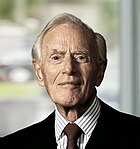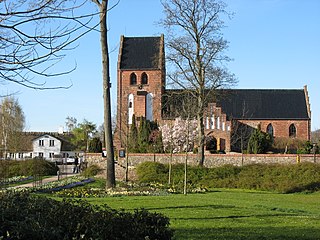
Birkerød is a town in Rudersdal Municipality in the northern outskirts of Copenhagen, Denmark. It is surrounded by several lakes and small woodlands. Birkerød station is located on the Hillerød radial of the S-train suburban network.

Gentofte Municipality is a municipality in the Capital Region of Denmark on the east coast of the island of Zealand (Sjælland) in eastern Denmark. It covers an area of 25.54 km2 (9.86 sq mi), and has a total population of 75,033. Since 17 May 2021, its mayor has been Michael Fenger, a member of the Conservative People's Party.
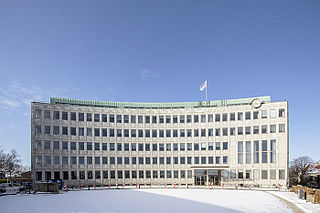
Lyngby-Taarbæk Municipality is a municipality in the Capital Region of Denmark near Copenhagen on the eastern coast of the island of Zealand. It is part of the Greater Copenhagen area. The municipality borders Rudersdal Municipality to the north, Furesø Municipality to the west and Gladsaxe and Gentofte Municipality to the south. It borders the Øresund to the east.

Hillerød is a Danish town with a population of 36,227 located in the centre of North Zealand approximately 30 km to the northwest of Copenhagen, Denmark. Hillerød is the administrative centre of Hillerød Municipality and also the administrative seat of Region Hovedstaden, one of the five regions in Denmark. It is most known for its large Renaissance castle, Frederiksborg Castle, now home to the Museum of National History. Hillerød station is the terminus of one of the radials of the S-train network as well as several local railway lines. The town is surrounded by the former royal forests of Gribskov to the north and Store Dyrehave to the south.

Kongens Lyngby is the seat and commercial centre of Lyngby-Taarbæk Municipality in the northern suburbs of Copenhagen, Denmark. Lyngby Hovedgade is a busy shopping street and the site of a branch of Magasin du Nord as well as Lyngby Storcenter. The district is also home to several major companies, including COWI A/S, Bang & Olufsen, ICEpower a/s and Microsoft. The Technical University of Denmark relocated to Lyngby from central Copenhagen in the 1970s. Lyngby station is located on the Hillerød radial of Copenhagen's S-train network.
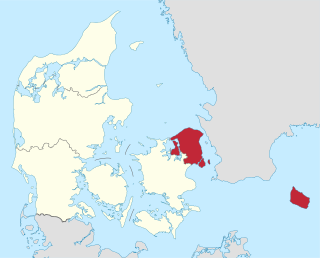
The Capital Region of Denmark is the easternmost administrative region of Denmark, and contains Copenhagen, the national capital.
Gentofte Sportspark is a multi-purpose stadium in Gentofte near Copenhagen, Denmark. The stadium holds 15,000 people. It is currently used mostly for football matches and is the home stadium of Hellerup IK. Other sports clubs based in the sports park include the ice hockey team Gentofte Stars and the badminton club Gentofte BK. The stadium has also been used for concerts.

Charlottenlund is a suburban area on the coast north of Copenhagen, Denmark. It is the administrative seat of Gentofte Municipality. Bordered to the east by the Øresund, to the South by Hellerup and to the north by Klampenborg, it is one of the wealthiest areas in Denmark. The neighbourhood takes its name after Charlottenlund Palace.

Hellerup is a very affluent district of Gentofte Municipality in the suburbs of Copenhagen, Denmark. The most urban part of the district is centred on Strandvejen and is bordered by Østerbro to the south and the Øresund to the east. It comprises Tuborg Havn, the redeveloped brewery site of Tuborg Breweries, with the Waterfront Shopping Center, a marina and the headquarters of several large companies. Other parts of the district consist of single family detached homes. Local landmarks include the science centre Experimentarium and the art Øregaard Museum.
Gudmund Nyeland Brandt was a Danish landscape architect who was internationally renowned.
Sven Julius Risom was a Danish architect who worked mainly in the style of Nordic Classicism.

Jægersborg is a suburban neighbourhood in Gentofte Municipality, some 12 km north of central Copenhagen, Denmark.

Ordrup is a district of Gentofte Municipality in the northern suburbs of Copenhagen, Denmark. It is located circa 12 km (7.5 mi) north of the city centre.

Esbønderup is a parish and small town situated north of Lake Esrum in Gribskov Municipality, North Zealand. some 40 km (25 mi) north of Copenhagen, Denmark. As of 1 January 2024, it had a population of 1,284.

The Øregård Gymnasium is a gymnasium in the Hellerup district of Gentofte Municipality in the northern suburbs of Copenhagen, Denmark. The neoclassical main building from 1924 is listed.

Lyngby Lake is a lake located on the border between Lyngby-Taarbæk and Gladsaxe municipalities in the northern suburbs of Copenhagen, Denmark. It is the smallest of the four lakes that are located on Mølleåen. At the east end of the lake is an embankment with a lake promenade, S-train line and Lyngby bypass. A small portion of the lake, known as Lille Lyngby Sø is located on the east side of the embankment.
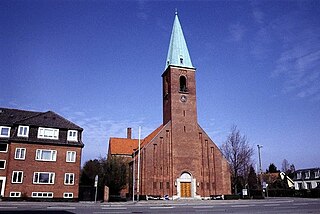
Bernstorffsvej is a major road in the Gentofte Municipality, located in the northern suburbs of Copenhagen, Denmark. It runs from Lyngby to a five-way roundabout on Jægersborg Allé in the north. The road passes several notable Danish buildings, including Gentofte Town Hall, Helleruplund Church, the Roman Catholic, St. Theresa's Church, Hellerup Cemetery and Bernstorff Park.
Jægersborg Allé is a major street in the Charlottenlund and Jægersborg neighborhoods of Gentofte Municipality in the northern suburbs of Copenhagen, Denmark. It runs from Strandvejen in the southeast to a junction just east of Jægersborg railway station in the northwest. The first leg of the road passes through Charlottenlund Forest, and it later follows the north boundary of Bernstorff Park. It passes a number of historic buildings, including Charlottenlund Palace, Bernstorff Palace and Schæffergården.

Constituencies are used for elections to the Folketing, the national parliament of Denmark. Denmark proper is divided into 10 constituencies largely corresponding to the Provinces of Denmark, each electing multiple members using open-list proportional representation. Those constituencies are then divided into 92 opstillingskredse which mainly serve the purpose of nominating candidates, but historically functioned as single-member constituencies electing one member using plurality voting.

The Copenhagen County District was an electoral district for the Danish parliament (Folketing) from 1920 to 2006. The county constituency consisted of Copenhagen County. The constituency was dissolved in the structural reform of 2007. Most of the area is now in the Greater Copenhagen constituency. However, the Amager district was transferred to the Copenhagen constituency, while three former municipalities to the north were transferred to the North Zealand constituency.









